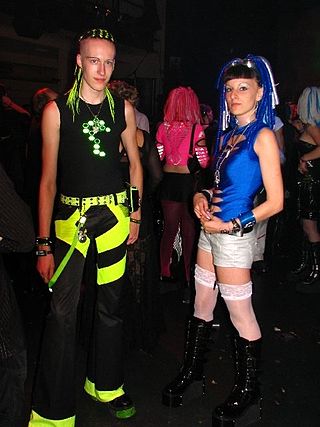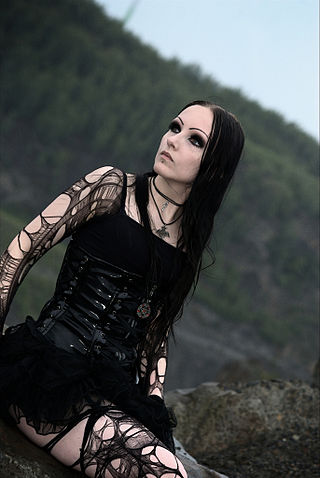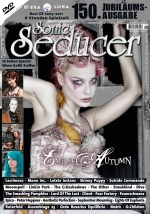
Goth is a music-based subculture that began in the United Kingdom during the early 1980s. It was developed by fans of gothic rock, an offshoot of the post-punk music genre. Post-punk artists who presaged the gothic rock genre and helped develop and shape the subculture include Siouxsie and the Banshees, Bauhaus, the Cure, and Joy Division.
Gothic rock is a style of rock music that emerged from post-punk in the United Kingdom in the late 1970s. The first post-punk bands which shifted toward dark music with gothic overtones include Siouxsie and the Banshees, Joy Division, Bauhaus, and the Cure.
Deathrock is a rock music subgenre incorporating horror elements and gothic theatrics. It emerged from punk rock on the West Coast of the United States in the early 1980s and overlaps with the gothic rock and horror punk genres. Notable deathrock acts include Christian Death, Kommunity FK, 45 Grave, and Super Heroines.

Gothic fashion is a clothing style worn by members of the goth subculture. A dark, sometimes morbid, fashion and style of dress, typical gothic fashion includes black dyed hair and black clothes. Both male and female goths can wear dark eyeliner, dark nail polish and lipstick, and dramatic makeup. Styles are often borrowed from the Elizabethans and Victorians. BDSM imagery and paraphernalia are also common. Gothic fashion is sometimes confused with heavy metal fashion and emo fashion.
Dark wave is a music genre that emerged from the new wave and post-punk movement of the late 1970s. Dark wave compositions are largely based on minor key tonality and introspective lyrics and have been perceived as being dark, romantic and bleak, with an undertone of sorrow. The genre embraces a range of styles including cold wave, ethereal wave, gothic rock, neoclassical dark wave and neofolk.
A rivethead or rivet head is a person associated with the industrial dance music scene. In stark contrast to the original industrial culture, whose performers and heterogeneous audience were sometimes referred to as "industrialists", the rivethead scene is a coherent youth culture closely linked to a discernible fashion style. The scene emerged in the late 1980s on the basis of electro-industrial, EBM, and industrial rock music. The associated dress style draws on military fashion and punk aesthetics with hints of fetish wear, mainly inspired by the scene's musical protagonists.

Cybergoth is a subculture that derives from elements of goth, raver, rivethead and cyberpunk fashion.

George Lawrence Petros is an American art designer, author, editor, interviewer and illustrator. From 1984 through 1992 he published and edited EXIT, a punk-inspired art and science fiction magazine he founded with Adam Parfrey and Kim Seltzer. From 1992 through 2000 he edited and art-directed Seconds, an all-interview music and culture magazine founded by Steven Blush. From 2000 through 2005 he was a contributing editor of Juxtapoz, the low-brow art magazine founded by Robert Williams, and the senior editor of Propaganda, a goth/industrial music and style magazine founded by Fred H. Berger. He is the author of Art That Kills: A Panoramic Portrait of Aesthetic Terrorism 1984-2001, The New Transsexuals: The Next Step In Human Evolution, and the editor of American Hardcore: A Tribal History.
Gothic metal is a fusion genre combining the aggression of heavy metal with the dark atmospheres of gothic rock. The music of gothic metal is diverse with bands known to adopt the gothic approach to different styles of heavy metal music. The genre originated during the early 1990s in the United Kingdom originally as an outgrowth of death-doom, a fusion of death metal and doom metal. Lyrics are generally dark and introspective with inspiration from gothic fiction as well as personal experiences.

Dark culture, also called dark alternative scene, is a mixture of thematically related subcultures including the goth and dark wave subculture, the dark neoclassical/dark ambient scene, parts of the post-industrial scene parts of neofolk and the early gothic metal scene. Dark culture's origin lies in followers of dark wave and independent music, but over the decades it has developed to a social network held together by a common concept of aesthetics, self-representation, and individualism. The musical preferences of the dark scene are characterized by a mix of styles ranging from gothic metal, to industrial dance music and dark ambient, to dark neoclassical, neo-medieval and dark folk music, to gothic rock, dark wave and post-punk, the darker ends of electropop.
The Toronto goth scene, the cultural locus of the goth subculture in Toronto, Ontario, Canada and the associated music and fashion scene, has distinct origins from goth scenes of other goth subcultural centres, such as the UK or Germany. Originally known as the "Batcavers", the term "goth" appeared only after 1988, when it was applied to the pre-existent subculture. Distinctive features included internationally recognized gothic and vampiric fashion store 'Siren', a goth-industrial bar named 'Sanctuary: The Vampire Sex Bar', and Forever Knight, a television series about an 800-year-old vampire living in Toronto. In Toronto, the goths did not seek to reject mainstream status, and achieved partial acceptance throughout the mid to late 1990s.
Bats Day in the Fun Park, also known as Bats Day, Goth Day, Goth Day at Disneyland, The Spooky Trip to Disneyland Resort, California., Bats Day in the Park and Bats Day Out, started in August 1999 as a joint effort between the promoters of the goth, industrial, and deathrock clubs Absynthe and Release the Bats. It has become an annual three-day event taking place in Anaheim, California, United States near Disneyland. In previous years, the events commenced on the weekend before Labor Day. Since about 2008, Bats Day event weekends have usually happened on the first or third weekend in May.
Rose Mortem is an American fashion designer, musician, model, and entrepreneur. Rose is most widely known for her dark romantic fashion stylings and as a member of the Gothic rock band The Awakening. She is a graduate of Harvard University.
Natasha Scharf is an author, disc jockey, presenter and journalist best known for her work publicising gothic, rock, metal and progressive metal music and subcultures. Since 2019, she has been the Deputy Editor of Prog.

Sonic Seducer is a German music magazine that covers gothic rock, new wave, EBM and other kinds of electronic music and culture. The magazine is noted for organizing the annual M'era Luna Festival. Since its inception in 1994, the Sonic Seducer has become one of the major publications of the dark culture in Germany.
Goliath Books is a publisher of art and photography books, founded in 1997 by Miki Bunge in New York. Goliath's objective is to publish diverse and daring photography and art books and to introduce controversial, erotic and fringe themes to a mainstream audience. Goliath continues to be noteworthy for their ongoing publication of artists who fall outside traditional practices. The publisher's ongoing mission is to explore and transform the public's approach to art, erotic themes, pornography and perspectives from a range of subcultures.
Orkus is a monthly German music and culture magazine published by the Zoomia Media Group. Despite its subtitle and its web tagline, it includes all popular music genres including metal, medieval rock, Neue Deutsche Härte, alternative rock, electro and futurepop. The gothic rock, dark wave and industrial music genres have had only a minor presence since the late 1990s.
Nancy Kilpatrick is a Canadian author who has written stories in the genres of dark fantasy, horror, mystery, erotic horror, and gothic subculture.
Bella Lune is a darkwave/dreampop band that was formed in 2007 in Phoenix, Arizona, USA. The band incorporates elements of darkwave, post-punk, synthpop, shoegaze, and ethereal music to create a dreamlike trance throughout their sound. Bella Lune cites many 80s post-punk and new wave bands as influences, including The Cure, Joy Division, Depeche Mode, Cocteau Twins, New Order, Siouxsie and the Banshees, Bauhaus, and Love and Rockets.






